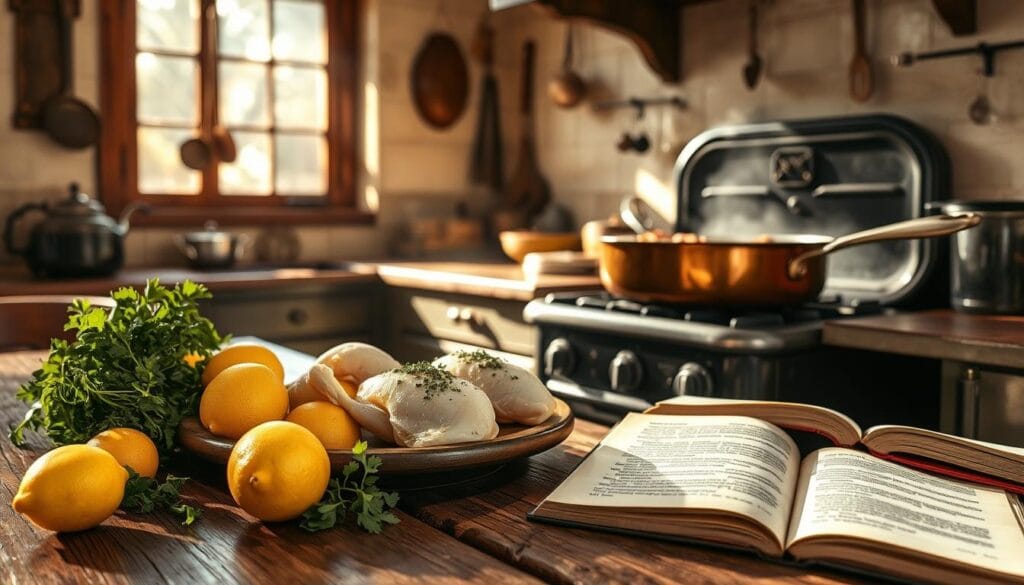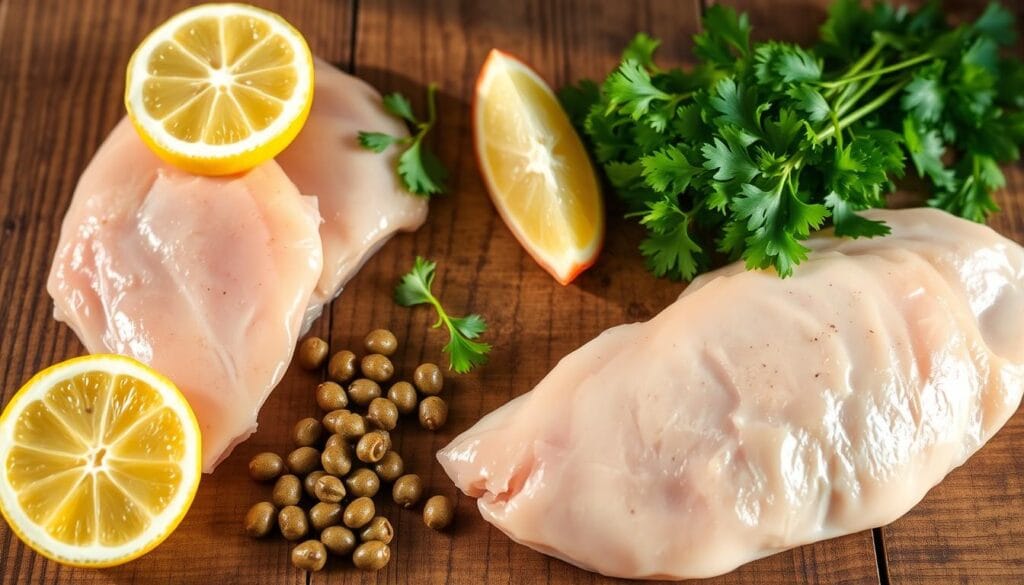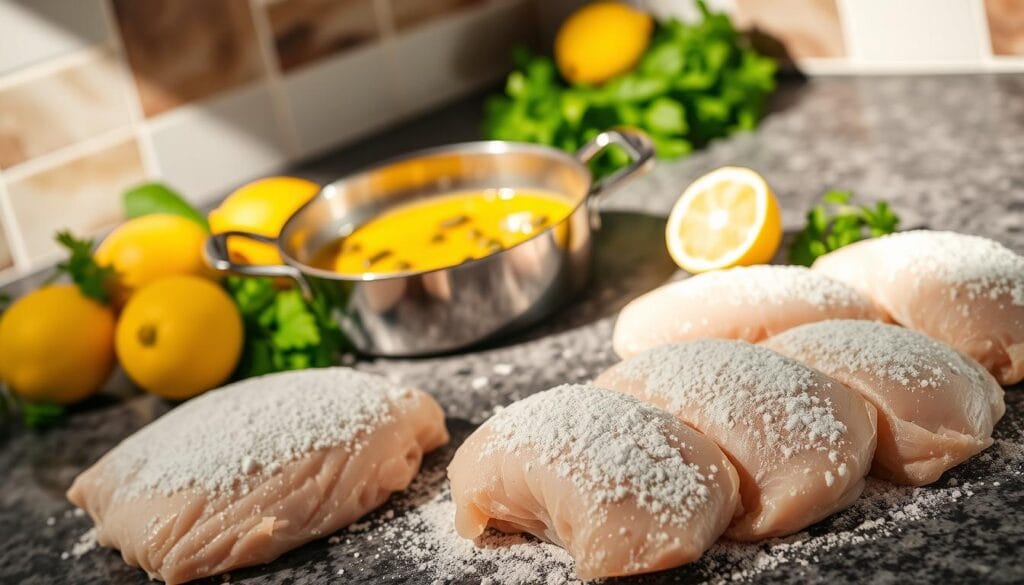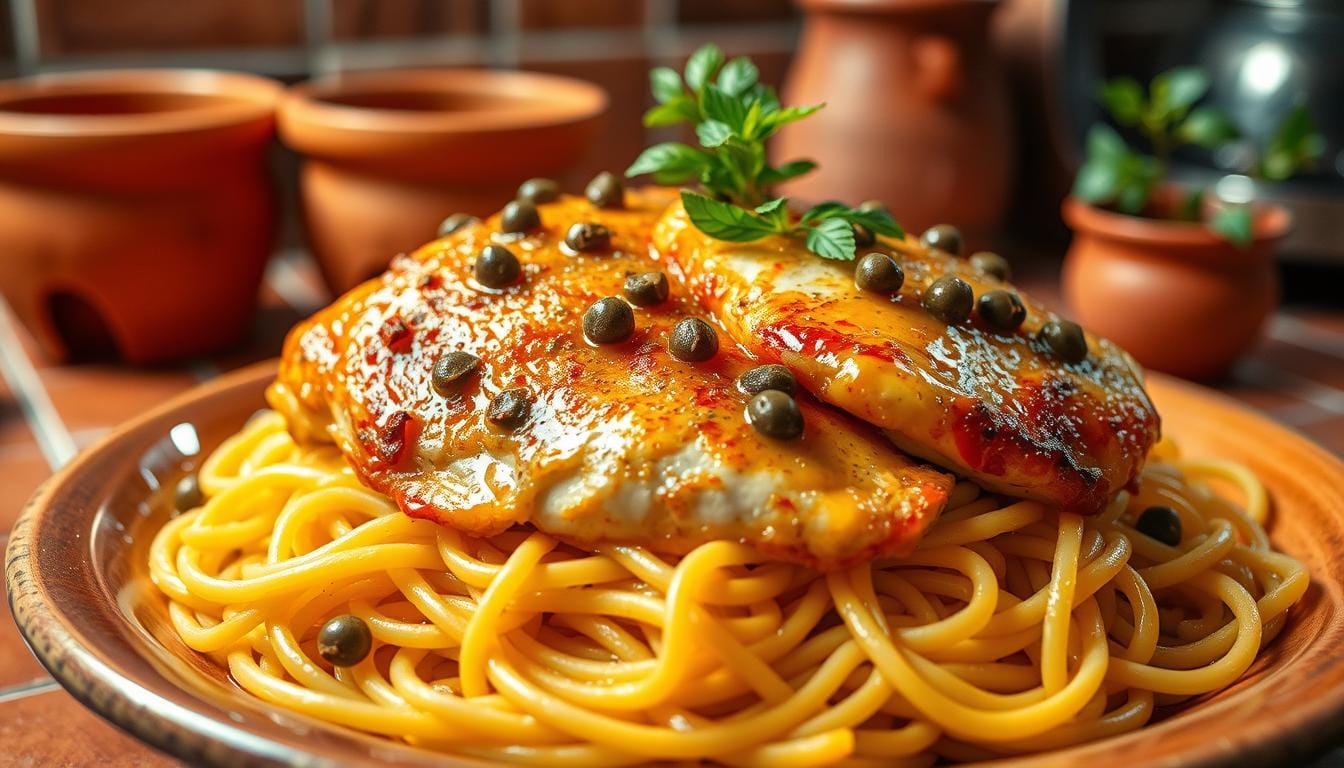Chicken Piccata: A Classic Italian-Inspired Dish
The first time I tasted chicken piccata, it was a culinary revelation. The bright, tangy lemon sauce danced across tender chicken cutlets. It created a symphony of flavors that took me to a cozy Italian kitchen. This dish isn’t just a meal—it’s an experience that connects food lovers with generations of culinary tradition.
Chicken piccata is the perfect mix of simple ingredients turned into an extraordinary dish. Imagine thin, golden-brown chicken breasts under a zesty sauce. The sauce is bursting with capers and fresh lemon, promising a burst of flavor in every bite.
This beloved Italian-American classic combines delicate chicken cutlets with a vibrant sauce. The sauce balances richness and brightness. Whether you’re a home cook or a culinary enthusiast, chicken-piccata offers a delightful journey into the heart of comfort cooking.
Table of Contents
Key Takeaways
- Chicken piccata is a classic Italian-inspired dish with roots in traditional Italian cuisine
- The recipe features tender chicken cutlets in a lemon-caper sauce
- Preparation typically takes around 40 minutes from start to finish
- The dish serves 4 people and provides approximately 246 calories per serving
- It offers a perfect balance of protein, fat, and bright, tangy flavors
Origins and History of Italian-American Chicken Piccata
Chicken piccata is a dish that shows how Italian cooking meets American creativity. It’s not just from Italy, but a mix of old European ways and new American tastes.

The tale of chicken piccata starts with scaloppine, a method from Italy. Back then, veal was the meat used. Italian immigrants brought this method to the U.S., where it changed in exciting ways.
Evolution from Traditional Scaloppine
In traditional Italian cooking, scaloppine means:
- Thinly slicing meat (usually veal)
- Coating the meat in flour
- Sautéing until golden brown
- Making a light, tangy sauce
Development in American Cuisine
When Italian cooking came to America, chicken replaced veal in piccata. This made the dish easier and cheaper for people to make at home.
Cultural Significance
Chicken piccata shows how Italian and American cooking come together. The sauce, with its lemon, butter, and capers, became a favorite in Italian-American places. It shows how immigrant cooking traditions can evolve and thrive.
Essential Ingredients for Perfect Chicken Piccata
You need the right ingredients to make a great lemon chicken dish. Chicken piccata is all about quality and precision. It turns simple items into a meal fit for a restaurant.

Key Components of the Dish
Start with the right ingredients for your garlic chicken. A good piccata needs a few key things:
- Boneless, skinless chicken breasts
- High-quality all-purpose flour
- Fresh lemons
- Briny capers
- Unsalted butter
- Extra virgin olive oil
- Fresh garlic cloves
- Low-sodium chicken stock
Selecting Quality Chicken Breasts
Your chicken breasts are the main attraction. Choose fresh, plump breasts without any discoloration. They should be the same thickness for even cooking.
Go for breasts that weigh 6-8 ounces. This size is easy to pound to a ½-inch thickness.
| Chicken Breast Criteria | Recommended Specifications |
|---|---|
| Weight | 6-8 ounces per breast |
| Thickness after pounding | ½ inch |
| Cooking temperature | 165°F internal temperature |
| Cooking time per side | 3-4 minutes |
Understanding the Role of Capers
Capers are the magic ingredient in your lemon chicken piccata. These tiny, pickled buds add a tangy, salty flavor. Rinse them before adding to keep their taste bright.
“Capers are like culinary jewels that transform an ordinary chicken dish into something extraordinary.” – Professional Chef
With the right ingredients and preparation, your chicken piccata will be full of flavor and look like it came from a restaurant.
Step-by-Step Preparation Method
Making delicious chicken piccata is all about precision. It’s a simple process that needs your full attention. You can turn plain chicken breasts into a gourmet dish in just 50 minutes.

Begin by slicing your chicken breasts in half lengthwise. This makes them thin and even. Thin slices ensure uniform cooking and a tender texture. Then, pat them dry with paper towels to help the flour stick well.
- Slice chicken breasts horizontally
- Pat chicken dry with paper towels
- Season with salt and black pepper
- Dredge chicken in all-purpose flour
To get a golden-brown crust, heat olive oil in a large skillet. Cook the chicken for 4-5 minutes on each side. This ensures it’s cooked to 165°F. Olive oil and butter work together to prevent burning and add crispiness.
| Ingredient | Quantity | Purpose |
|---|---|---|
| Chicken Breasts | 6 ounces each | Main protein |
| All-Purpose Flour | ½ cup | Coating and thickening |
| Olive Oil | 2 tablespoons | Cooking fat |
The last step is making the lemon butter sauce. Use the same pan to cook shallots and garlic. This makes a flavorful base for your sauce. Add chicken stock, white wine, and fresh lemon juice to enhance the flavors.
- Sauté shallots and garlic in pan drippings
- Add chicken stock and white wine
- Incorporate butter and capers
- Finish with fresh lemon juice
Mastering the Signature Lemon Butter Sauce
Making the perfect piccata sauce is like turning simple chicken into a work of art. The white wine sauce is the core of chicken piccata. It combines flavors that make your taste buds dance.
Creating the Perfect Sauce Base
To start your lemon butter sauce, heat olive oil and butter in a skillet. Add minced garlic (about 2 cloves) and sauté for 30 seconds. This step creates a rich, aromatic base that makes your dish shine.
- Use fresh capers for the best taste
- Opt for a crisp, dry white wine like Sauvignon Blanc
- Simmer to concentrate the sauce’s flavors
Achieving the Ideal Sauce Consistency
The secret to a perfect piccata sauce is its silky texture. After deglazing, add ½ cup of chicken broth and reduce for 2-3 minutes. Then, stir in 2 tablespoons of butter and ¼ cup of fresh lemon juice. Swirl the pan to mix everything into a smooth, emulsified sauce.
Pro tip: Remove the pan from heat while adding butter to prevent separation and ensure a smooth, glossy finish.
Tips for Perfectly Tender Chicken
Mastering chicken piccata is all about precision and technique. This ensures your dishes are juicy and full of flavor. The secret is in how you prepare and cook the chicken.
- Pound chicken breasts to an even ½-inch thickness for consistent cooking
- Use a meat mallet to tenderize the chicken gently
- Season chicken generously with salt and pepper before dredging
- Shake off excess flour to prevent burning during cooking
Cooking technique is vital for tender chicken. Heat olive oil in a skillet until it shimmers. Then, cook chicken cutlets for 2-3 minutes per side. This creates a golden brown exterior that keeps the chicken moist.
“The key to perfect chicken piccata is thin, evenly cut cutlets that cook quickly and stay tender.”
Cooking Temperature and Timing
Always check that your chicken reaches 165°F. Use a meat thermometer to ensure it’s done without cutting into it. This helps keep the juices inside.
| Cooking Metric | Recommended Value |
|---|---|
| Cutlet Thickness | ½ inch |
| Cooking Time per Side | 2-3 minutes |
| Internal Temperature | 165°F |
By following these tips, you’ll make a chicken piccata that’s tender, flavorful, and will wow your guests.
Wine Pairing and Serving Suggestions
Make your Italian dinner special with the right wine and sides. The perfect pairings can turn chicken piccata into a memorable meal.
Complementary Wine Selections
Choose crisp white wines for chicken piccata. These wines match the dish’s bright flavors. Their acidity balances the rich lemon butter sauce.
| Wine Type | Flavor Profile | Serving Temperature |
|---|---|---|
| Sauvignon Blanc | Vibrant citrus, high acidity | 45-50°F |
| Pinot Grigio | Refreshing, light citrus notes | 45-50°F |
| Pinot Noir | Light red fruit, soft tannins | 55-60°F |
Side Dish Recommendations
Try these side dishes with your chicken piccata:
- Creamy mashed potatoes
- Garlic roasted asparagus
- Angel hair pasta with herb butter
- Soft polenta
- Risotto with parmesan
Plating Techniques
Make your dish look great with these plating tips:
- Use a white plate to highlight the golden chicken
- Drizzle sauce artfully around the chicken
- Garnish with fresh parsley
- Place lemon wedges on the side
Pro tip: Serve your chicken piccata immediately after cooking to maintain its crisp texture and vibrant flavors.
Common Cooking Mistakes to Avoid
Mastering chicken piccata needs precision and focus. Even skilled cooks can make mistakes. Knowing common errors helps you make perfect piccata sauce and tender chicken.
Critical Cooking Errors to Watch Out For
- Overcrowding the skillet, which prevents proper chicken searing
- Using incorrect pan temperature
- Failing to properly pound chicken breasts
- Overlooking sauce consistency
- Mishandling capers in the piccata sauce
To make great chicken piccata, aim for a golden-brown crust and keep it moist. Cook in small batches to ensure each piece touches the hot pan. This method stops steaming and helps with caramelization.
Perfecting the Piccata Sauce
Your piccata sauce needs careful attention. Reduce it slowly and watch for the right consistency. Too thick and it’s heavy; too thin and it lacks flavor.
Seasoning and Technique
| Mistake | Solution |
|---|---|
| Over-salting | Taste and adjust gradually |
| Too many capers | Use 1/4 cup, drained and rinsed |
| Uneven chicken thickness | Pound to consistent 1/4 inch thickness |
Chicken piccata needs precise cooking. Use a meat thermometer to check the chicken’s internal temperature. This ensures it’s safe and juicy without overcooking.
Pro tip: Always let your chicken rest for a few minutes after cooking to retain maximum juiciness.
Storage and Reheating Guidelines
Keeping your dinner recipes fresh is key. Lemon chicken-piccata is especially delicate. It needs careful handling to keep its taste and quality.
- Refrigerate within 2 hours of cooking
- Store in an airtight container
- Keep refrigerated for up to 3-4 days
- Separate chicken from sauce to prevent sogginess
Freezing lemon chicken needs a plan. Wrap the chicken and sauce separately in freezer-safe containers. You can freeze it for up to 3 months. Here’s how to reheat it:
- Thaw in the refrigerator overnight
- Reheat gently in a skillet over low heat
- Add a splash of chicken stock to prevent drying
- Heat until the internal temperature reaches 165℉
“The key to great leftover lemon chicken is gentle reheating and preserving the sauce’s delicate flavor.” – Professional Chef
For a zesty touch, squeeze a fresh lemon wedge over the chicken before serving. This trick brings back the dish’s bright lemon flavor.
Conclusion
Your journey into chicken piccata has shown you a tasty Italian dish. It turns simple parts into a fancy meal. With just 30 minutes of prep, you can make a meal for four that everyone will enjoy.
Chicken-piccata is very flexible. It’s perfect for any meal, from a weeknight dinner to a special occasion. Learning to pound chicken and make a great lemon butter sauce will help you cook more than just this dish.
Great cooking is all about trying new things and adding your own touch. Feel free to change the recipe or try different wines. The main thing is to know the basic skills that make chicken-piccata a classic. Enjoy the process, savor the flavors, and share your dish with loved ones.
Now you know how to make this beloved Italian-American dish. It’s sure to wow your family and friends. So, get your skillet ready, gather your ingredients, and start cooking!
FAQ
What is chicken-piccata?
Is chicken piccata traditionally made with chicken or veal?
What are capers, and why are they important in chicken piccata?
How do I prevent my chicken from becoming tough when making piccata?
What wines pair best with chicken-piccata?
Can I make chicken piccata ahead of time?
Are there any gluten-free alternatives for dredging the chicken?
What are some good side dishes to serve with chicken-piccata?
How can I make the sauce if I don’t have white wine?
What’s the best way to store leftover chicken piccata?
How Was It?
There are no reviews yet. Be the first one to write one.

